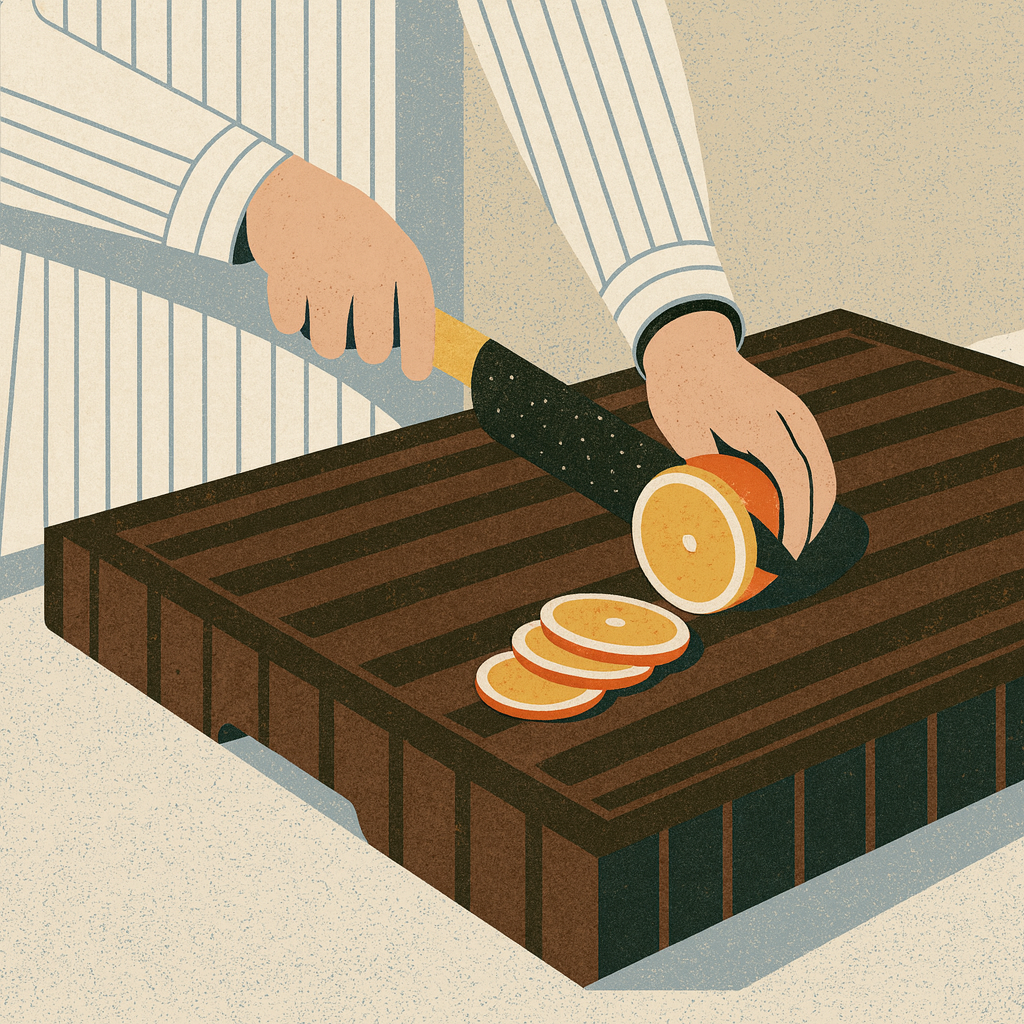After 15 years of cooking professionally and testing dozens of cutting boards, I’ve learned that a quality wooden cutting board is more than just a kitchen tool – it’s an investment in your cooking experience. I’ve chopped, diced, and sliced on every type of wood surface imaginable, and I’m here to share what really matters when choosing the best wooden cutting boards for your kitchen.
Table of Contents (It’s a long read)
- Why Choose a Wooden Cutting Board?
- Best Wooden Cutting Boards in 2025
- Premium Pick: John Boos 2.25" Maple End Grain Block
- Best Value: Teakhaus Edge Grain Rectangle
- Top End-Grain Pick: Shumaru 2.25-Inch Thick XXX-Large End-Grain Butcher Block
- Best Edge-Grain: Sonder LA Acacia board
- Made in the USA: Virginia Boys Kitchens Walnut board
- My Personal Pick: Ironwood Gourmet acacia board
- Size and Thickness Considerations
- Essential Maintenance for Your Wooden Cutting Boards
- In Conclusion
Why Choose a Wooden Cutting Board?
The TL/DR;
- Natural antibacterial properties of wood compared to plastic
- The gentle effect on knife blades and edge retention
- Sustainability aspects of different wood types
- Aesthetic value and how it enhances kitchen appearance
Natural antibacterial properties of wood
Here’s the thing about wooden cutting boards that most people don’t realize – they’re actually naturally antibacterial. I know, it sounds counterintuitive, right? But wood contains compounds that actively fight bacteria, while those little knife scratches in plastic boards become perfect breeding grounds for nasty germs. I learned this the hard way after sending a plastic board through the dishwasher countless times, only to find it warped and scarred beyond recognition.
The gentle effect on knife blades and edge retention
But the real game-changer? The way wooden boards treat your knife blades. Listen, I’ve destroyed my fair share of expensive knives on glass and bamboo cutting boards (don’t get me started on that glass cutting board phase – what was I thinking?). A quality wooden board actually helps maintain your knife’s edge. It’s like a little cushion for your blade, allowing it to slice through without dulling. After switching to wood, I noticed I needed to sharpen my knives way less frequently.
Sustainability aspects of different wood types
And can we talk about sustainability for a minute? When I started researching wooden boards more seriously, I discovered that many quality manufacturers source their wood from sustainable forests. My favorite maple board comes from a company that plants three trees for every one they use. Compare that to plastic boards that’ll sit in a landfill for centuries. It’s pretty much a no-brainer.
Aesthetic value and how it enhances kitchen appearance
The aesthetic factor is just icing on the cake. My wooden board doubles as a gorgeous serving platter for charcuterie, and honestly, it’s become a focal point of my kitchen. Guests always comment on it, which usually leads to me geeking out about wood grain patterns (sorry, not sorry!).
Now, I’m not gonna pretend wooden boards are perfect – they do require some maintenance (more on that later). But here’s what sealed the deal for me: I’ve had the same end-grain maple board for eight years now, and it’s still going strong. Meanwhile, I was replacing plastic boards every year or two. Do the math, and the wooden board actually works out cheaper in the long run.
Best Wooden Cutting Boards in 2025
- Premium Pick: John Boos 2.25″ Maple End Grain Block – Why it’s worth the investment. Without doubt, the best wooden cutting board
- Best Value: Teakhaus Edge Grain Rectangle – Where it excels and compromises
- Top End-Grain Pick: Shumaru 2.25-Inch Thick XXX-Large End-Grain Butcher Block – Professional kitchen standard
- Best Edge-Grain: Sonder LA Acacia board
- Made in the USA: Virginia Boys Kitchens Walnut board – 100% sustainable walnut wood grown in America
- My Personal Pick: Ironwood Gourmet acacia board – my daily driver for the past three years
Premium Pick: John Boos 2.25″ Maple End Grain Block
Let’s start with my absolute premium pick – the John Boos 2.25″ Maple End Grain Block.
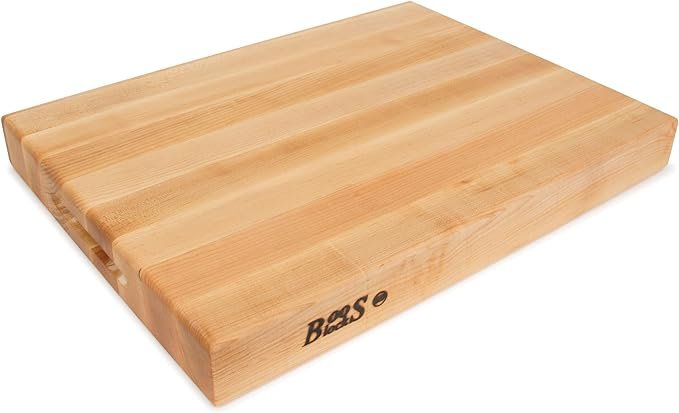
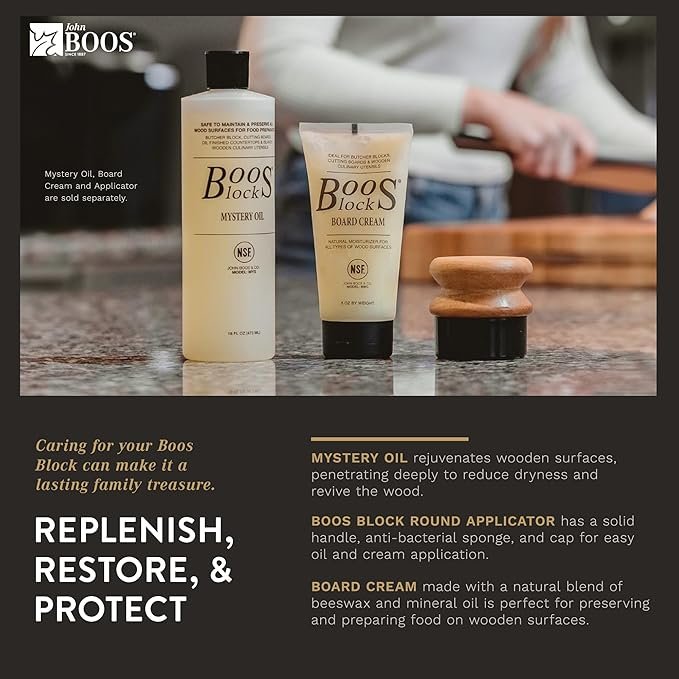
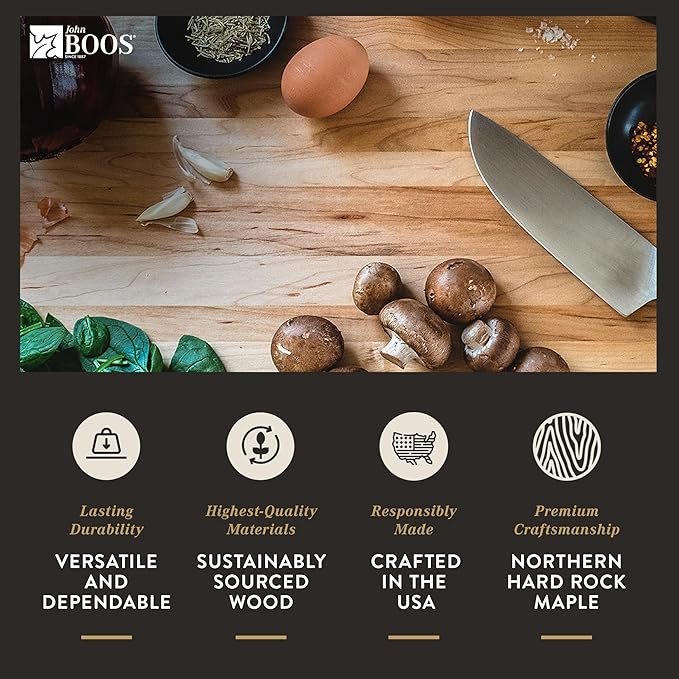
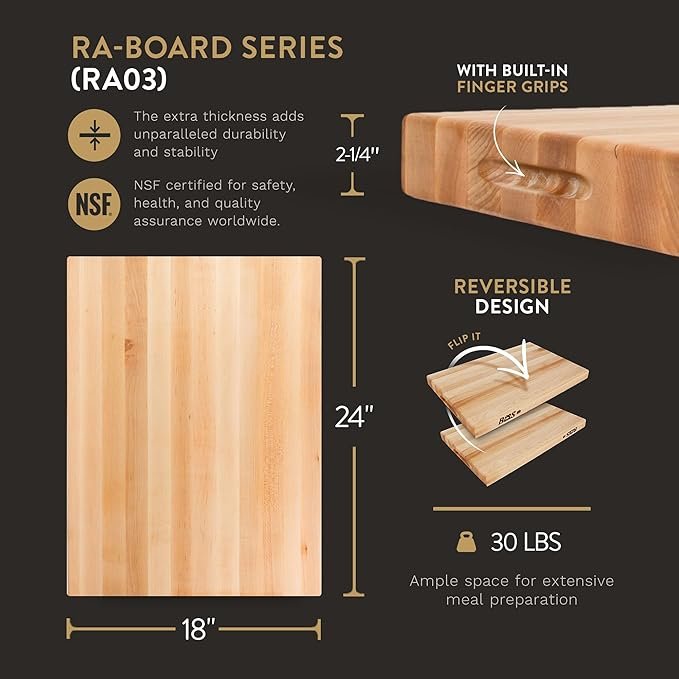
Yeah, I know, it’s not cheap, but hear me out. This beast is what we use in my cooking classes, and it can handle everything from delicate herb chopping to breaking down whole chickens. The thickness is no joke – it barely moves on the counter, even during heavy-duty chopping. What really sold me was watching it handle a class of 20 beginners practicing their knife skills and still looking pristine afterward. When it comes to the best wooden chopping board, look no further.
Best Value: Teakhaus Edge Grain Rectangle
Now, for the best value pick that won’t make your wallet cry, I’ve been super impressed with the Teakhaus Edge Grain Rectangle board, and it’s become my go-to recommendation for most home cooks.
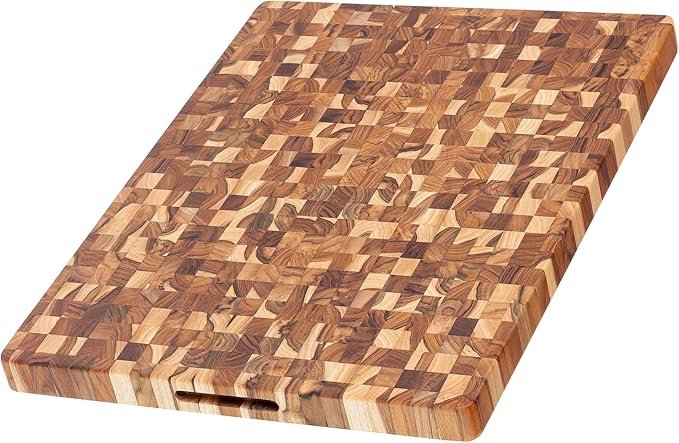
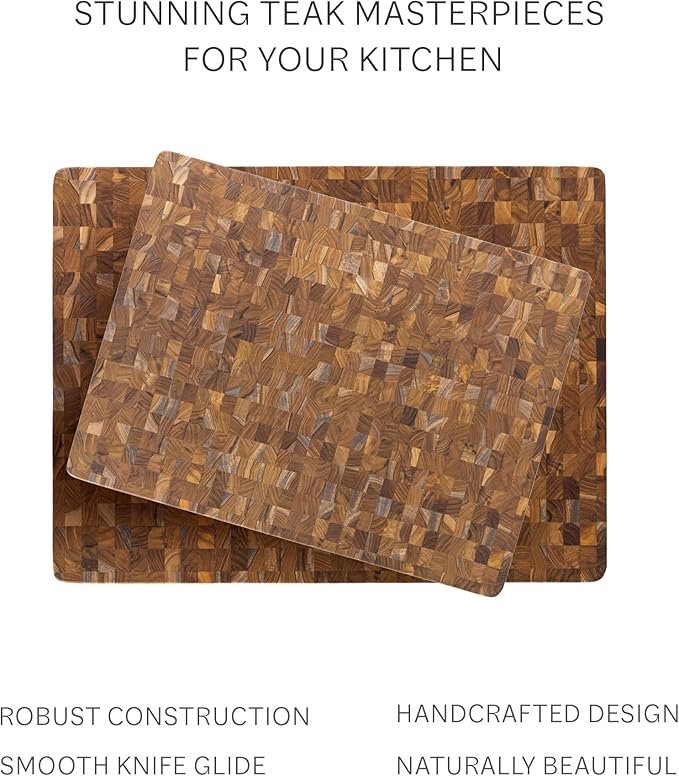
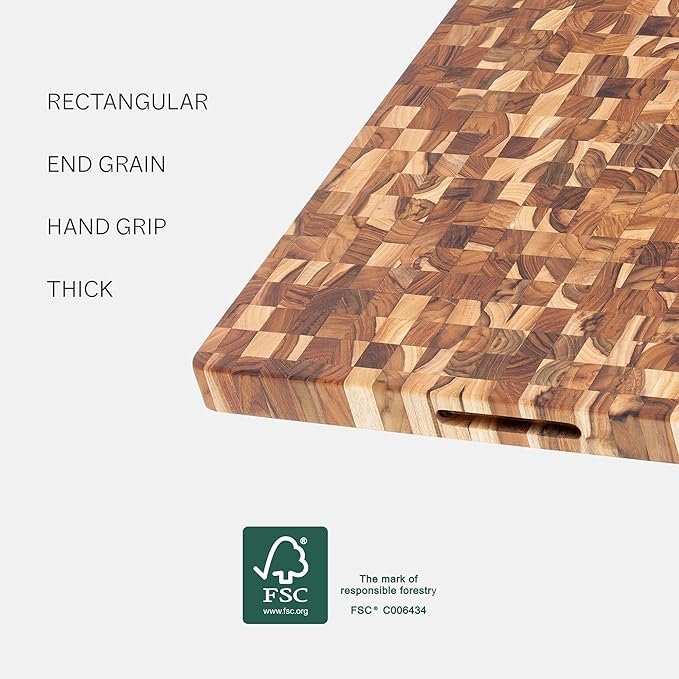
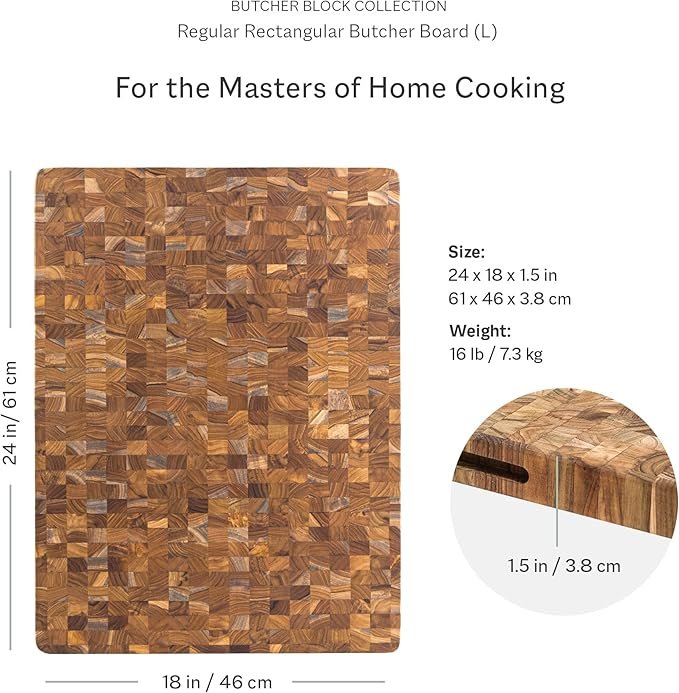
At around $100, you’re getting professional-grade durability without the professional-grade price tag. Just remember to oil it regularly – I learned that lesson the hard way after letting mine sit dry for too long.
Top End-Grain Pick: Shumaru 2.25-Inch Thick XXX-Large End-Grain Butcher Block
Here’s where I might ruffle some feathers, but I stand by it – the Shumaru 2.25-Inch Thick XXX-Large End-Grain Butcher Block is hands-down the best end-grain option out there right now. Similar in price to the Boos ($200-ish), but the craftsmanship is next level.
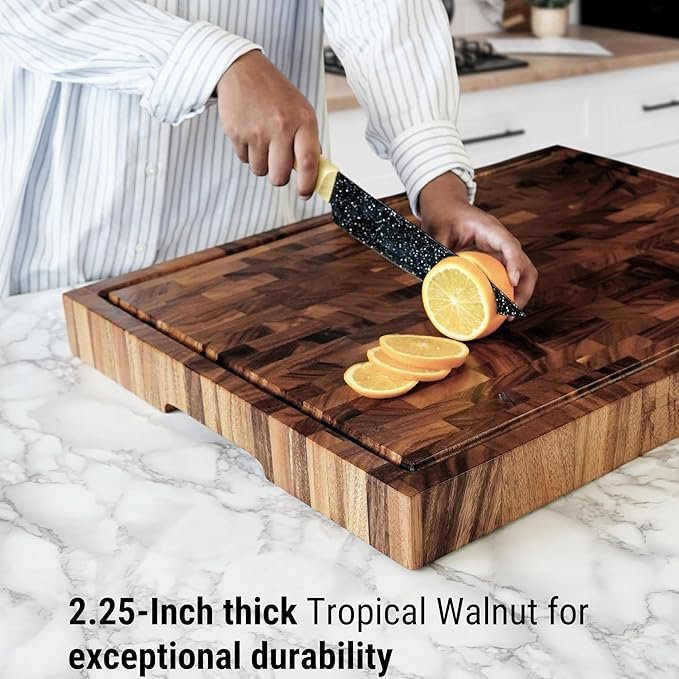
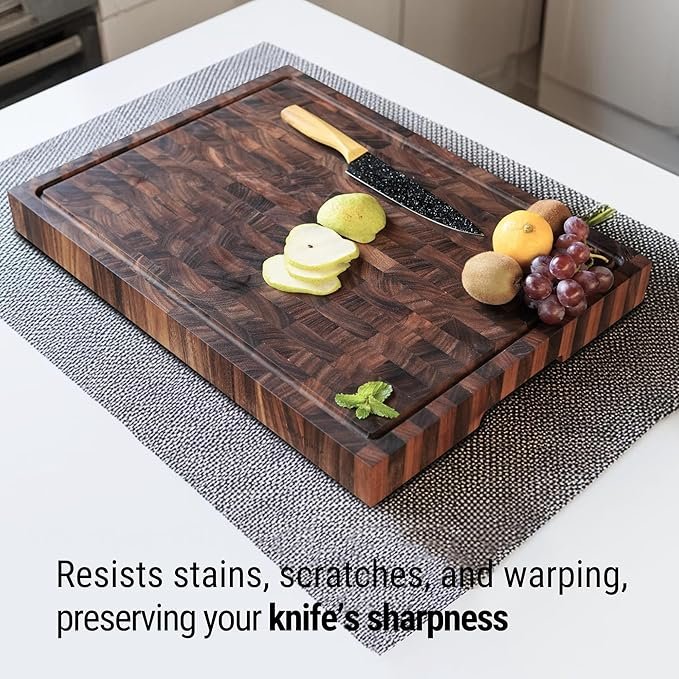
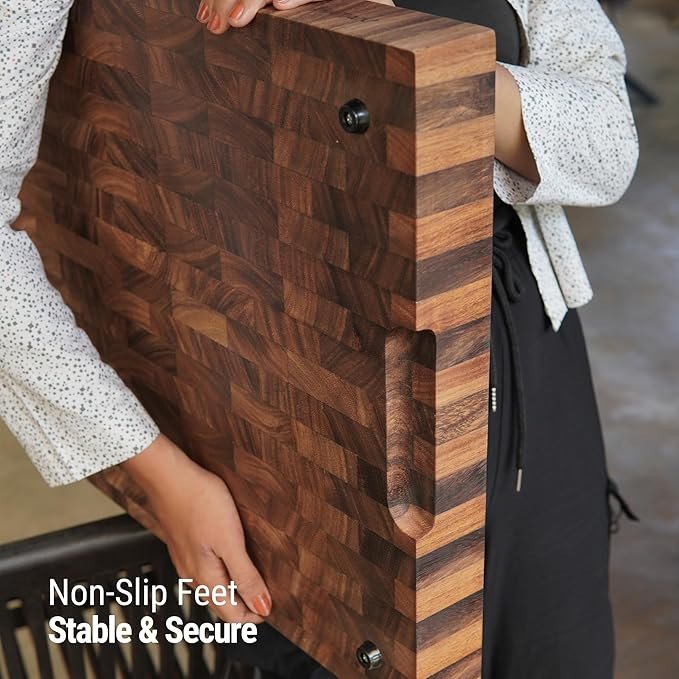
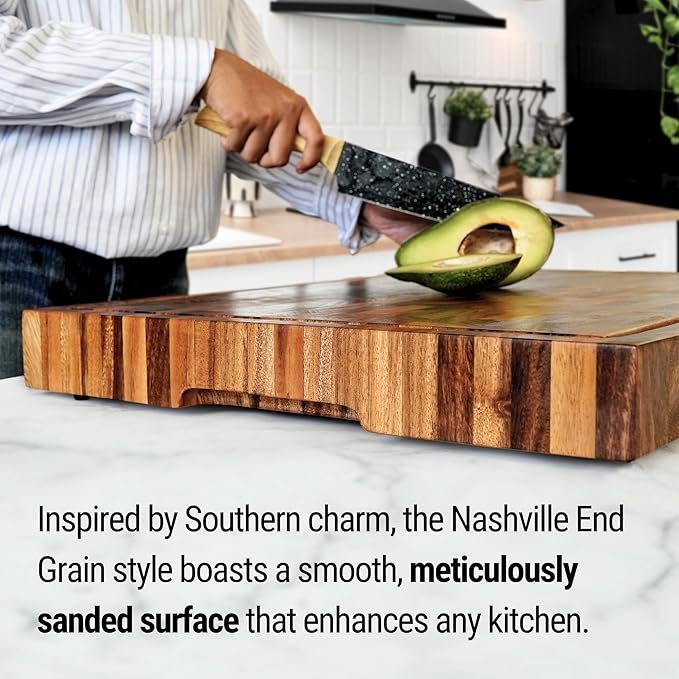
Hand crafted boards from sustainable sources in Bali and Java, they look utterly spectacular and are built to last.
Best Edge-Grain: Sonder LA Acacia board
For everyday use, I’ve been loving my Sonder LA Acacia board. It’s edge-grain construction, but don’t let that fool you – this board can take a beating.
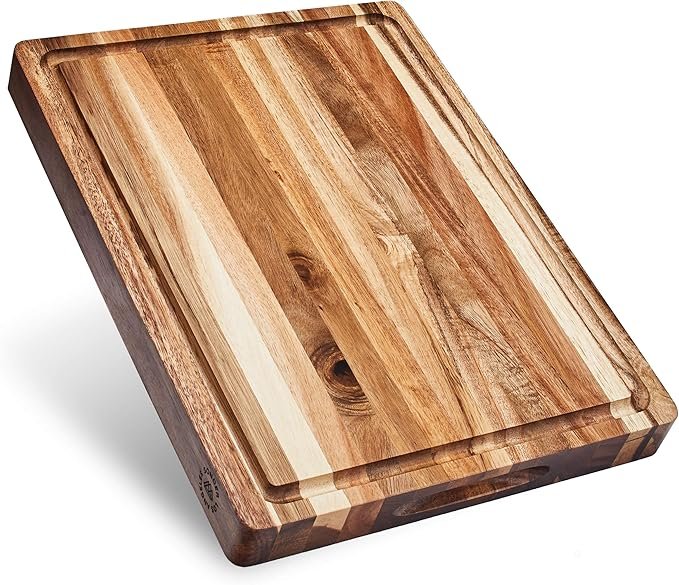
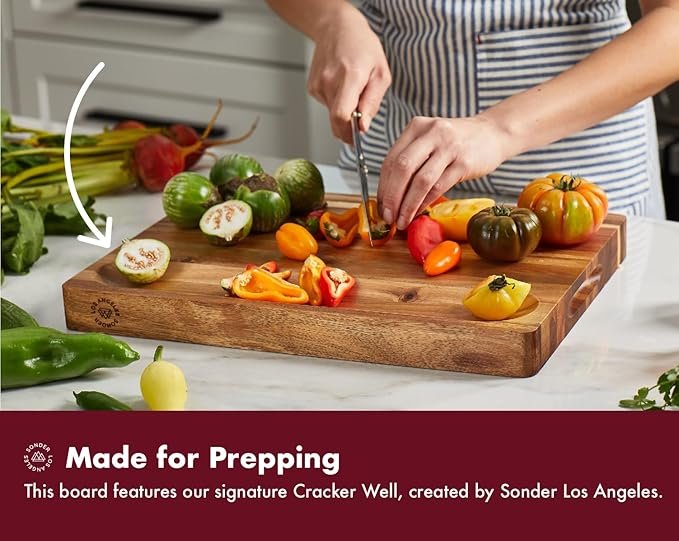
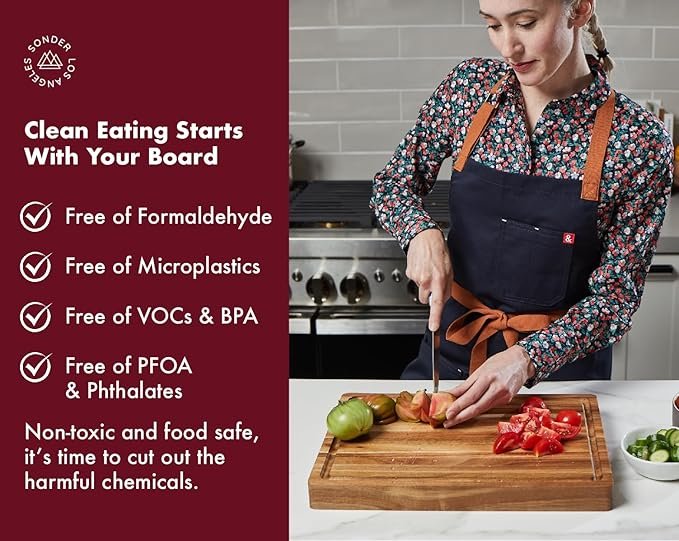
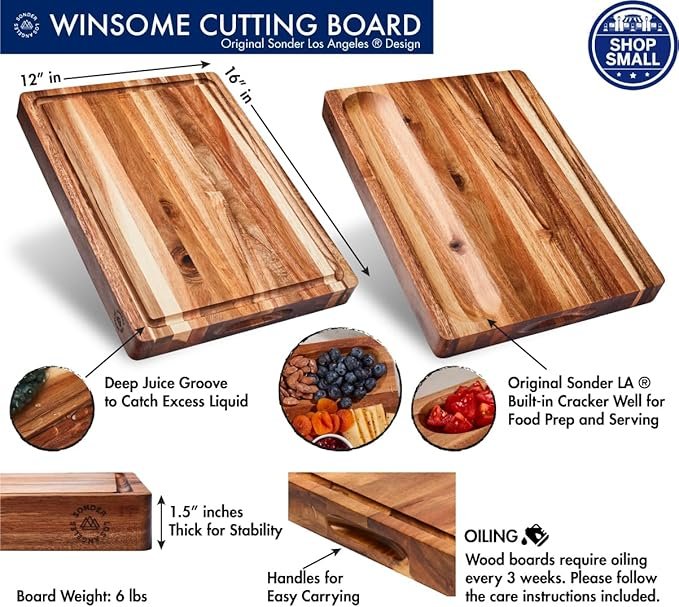
I’ve had mine for about eight months now, using it daily, and it still looks almost new. The juice groove actually works (unlike some others I’ve tried), and at around $130, it’s a solid mid-range option.
Made in the USA: Virginia Boys Kitchens Walnut board
Can we talk about the Virginia Boys Kitchens Walnut board? Sustainably sourced only from American forests, the VBK boards are excellent quality that will last a lifetime.
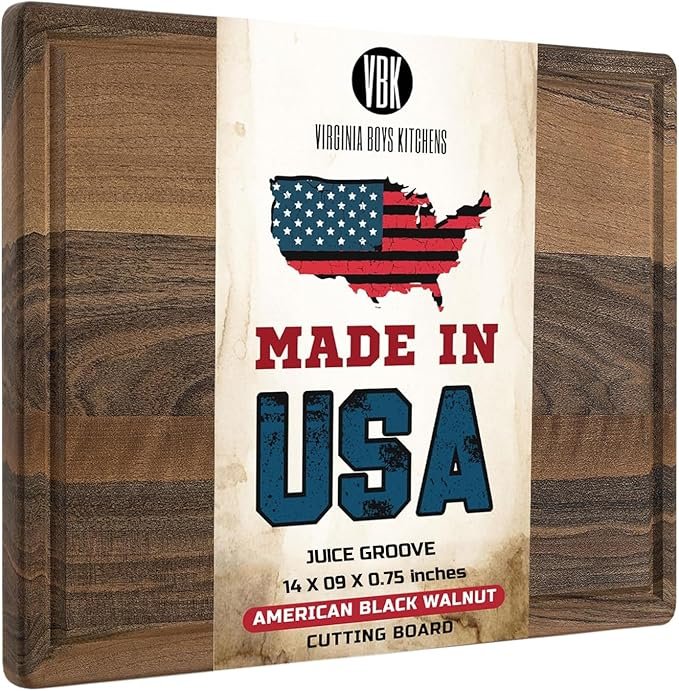
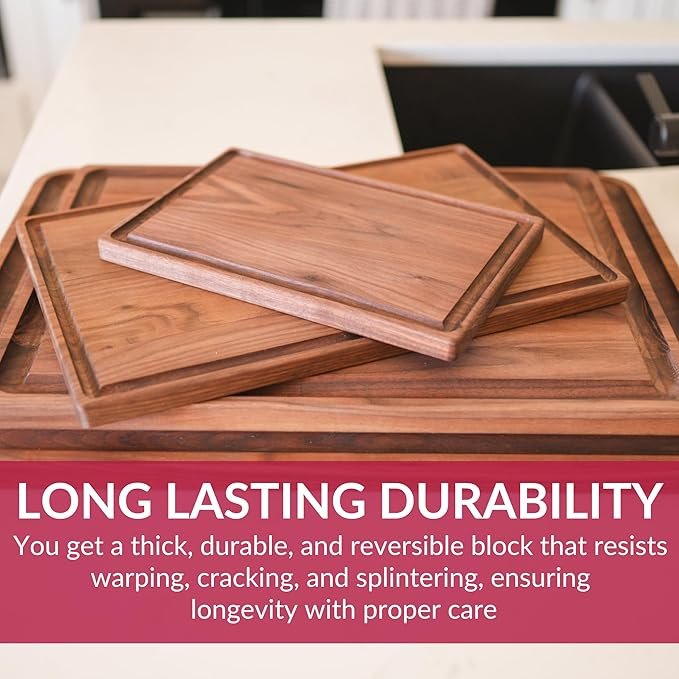
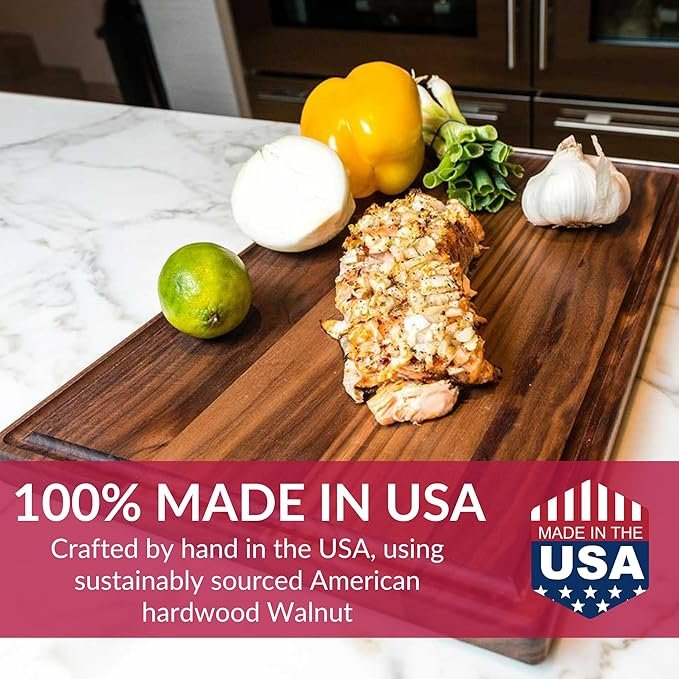
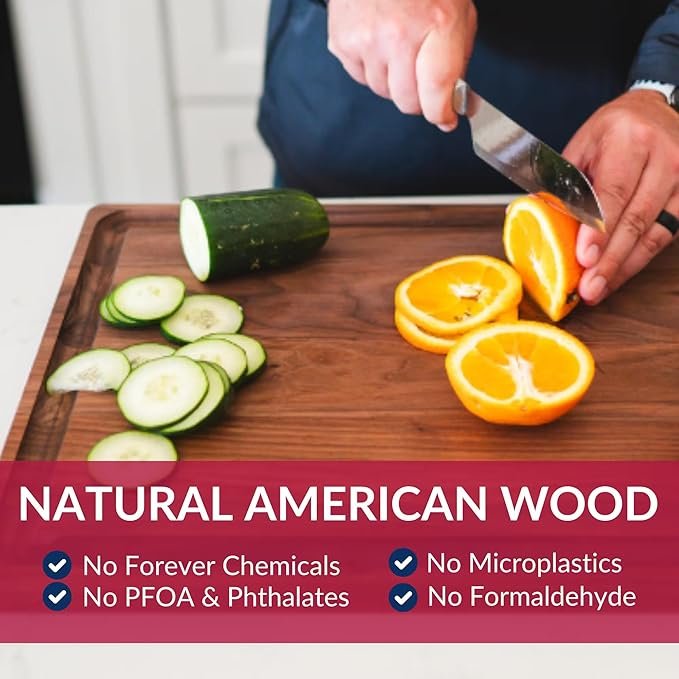
The boards are intentionally reverisble, with one side for cutting and the other for presenting (cheese, chacuterie, etc). And to top it all, they plant a tree for every board they sell. Pro tip: get the 14×9 size – anything smaller and you’ll feel cramped while chopping.
My Personal Pick: Ironwood Gourmet acacia board
Let me share a little secret: the board I actually use most often in my own kitchen isn’t even the most expensive one I own. It’s my trusty Ironwood Gourmet acacia board that I picked up three years ago. The thing is, cutting boards are like good knives – the best one is the one you’ll actually use and maintain properly.
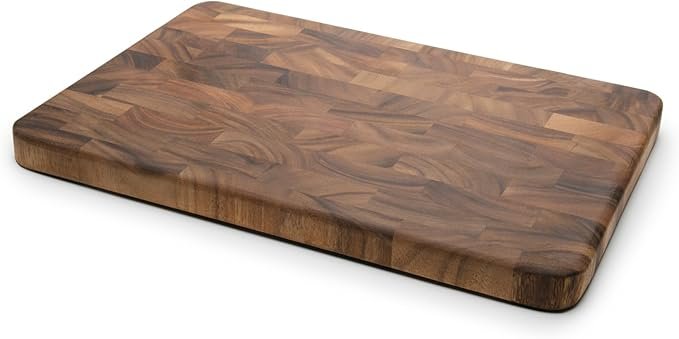
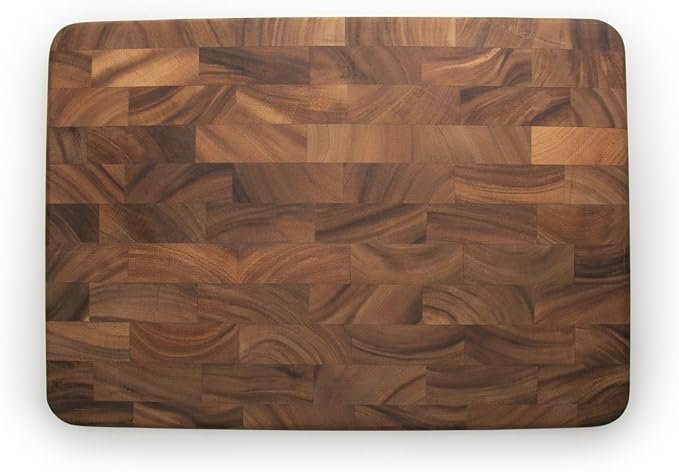
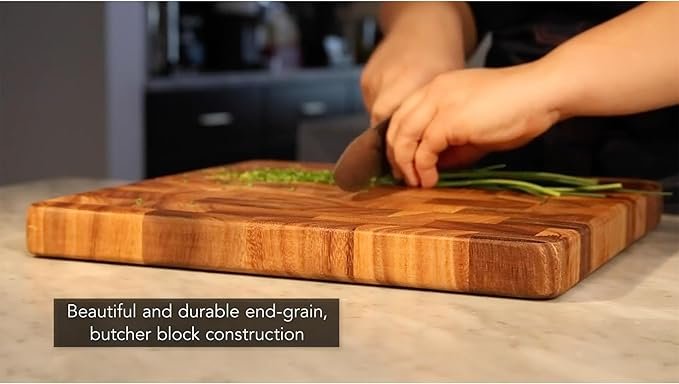
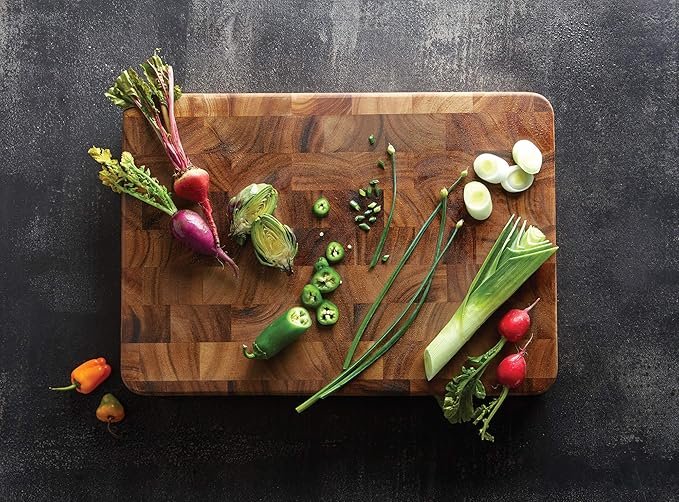
Ironwood were founded in 2002 and focus purely on acacia wood, known for its unique and natural contrasting patterns. I’ve been really happy with how the board has stood up to constant use over the past three years and would certainly recommond this to anyone looking for a very well priced sturdy board.
Here’s what I tell my friends & colleagues: invest in the best board you can afford, but don’t feel pressured to go straight for the top-tier options. My first “good” board was a mid-range maple edge-grain that I used for years before upgrading. The key is understanding what features matter for your cooking style. If you’re mainly chopping vegetables, you might not need that extra-thick butcher block designed for breaking down meat.
Size and Thickness Considerations
Standard sizes and their practical applications
Let me tell you about the biggest mistake I made when buying my first serious cutting board – I went too small. I remember thinking “12×16 inches (30×40 cm) sounds huge!” Boy, was I wrong. After prepping just one big family dinner, with vegetables rolling off onto the floor, I learned my lesson the hard way.
- Solid Wooden Cutting Board: Elevate your food prep with an RA-Board series John Boos wood cutting board. It’s ideal for …
- Crafted for Your Home: This thick wooden charcuterie board boasts reversible sides, recessed finger grips, an oil finish…
- Made for Life: Available in 4 different sizes for your serving and charcuterie board needs, this large wooden cutting bo…
You know what’s crazy? I used to think those massive cutting boards in cooking shows were just for looks. Then I started teaching cooking classes, and it hit me – size really does matter when it comes to cutting boards. I now tell all my students that a 15×20 inch (38×51 cm) board should be their minimum for a main board. Sure, it takes up counter space, but trust me, you’ll thank me when you’re prepping a big meal and not playing vegetable Jenga.
How thickness affects stability and durability
Here’s a real kitchen disaster story for you: I once had this gorgeous but super thin walnut board (maybe 3/4 inch (19 mm) thick). Looked beautiful, but it would dance around on the counter like it was auditioning for “So You Think You Can Dance.” After one too many close calls with my chef’s knife, I learned that thickness isn’t just about durability – it’s about safety too.
Let me break down what I’ve learned about thickness after years of testing boards in my kitchen:
- 1 inch (25 mm) thick: OK for small tasks, but you’ll notice some wobble
- 1.5 inches (38 mm): Now we’re talking – stable enough for most home cooking
- 2+ inches (50+ mm): Pro territory, amazing stability but holy moly, these are heavy!
Weight considerations for different kitchen setups
Speaking of weight, here’s something nobody tells you when you’re shopping for cutting boards – you need to think about where you’re going to store it. My current 2.25-inch (57 mm) thick end-grain board weighs about 15 pounds (7 kg). Yeah, it lives on my counter because I’m not lugging that beast in and out of a cabinet three times a day!
Size-wise, I’ve developed what I call the “comfort zone” theory. For most home cooks, a board around 18×24 inches (46×61 cm) hits the sweet spot. It’s big enough to handle most prep work but not so massive that it overtakes your counter. Although, I gotta admit, the 24×30 inch (61×76 cm) monster board I use for holiday prep is pretty sweet – even if my wife thinks it’s overkill.
The thickness of your board should also match your cooking style. I learned this from a butcher friend of mine – if you’re regularly breaking down whole chickens or doing heavy-duty chopping, you want at least 2 inches (50 mm) of thickness. For everyday vegetable prep and lighter work, 1.5 inches (38 mm) is plenty. Just don’t go below 1 inch (25 mm) unless you enjoy chasing your cutting board around the counter (been there, done that, got the T-shirt).
Storage implications of different sizes
Storage is another factor that took me way too long to figure out. My first apartment kitchen had these narrow cabinets, and let me tell you, trying to tetris a large cutting board in there was not fun. Now I recommend thinking about storage before buying. If you’ve got limited cabinet space, consider a board that’s pretty enough to leave out on display. My end-grain maple board doubles as kitchen decor, and I’m not even a little bit sorry about it.
Here’s a pro tip I wish someone had told me years ago: if you’re tight on space but still want a decent-sized board, get one with built-in feet. They add about 1/2 inch (12 mm) of height without the full thickness of a traditional board, and they allow for air circulation when stored vertically. Just make sure they’re rubber feet, not plastic – ask me how I know about that particular mistake!
The bottom line? Go bigger than you think you need, and don’t skimp on thickness. I’ve never heard anyone complain that their cutting board is too stable, but I’ve got plenty of stories about boards that were too small or too wobbly. Just remember – you’re not just buying a cutting board, you’re investing in a piece of equipment you’ll use every single day.
Essential Maintenance for Your Wooden Cutting Boards
Let me tell you about the day I almost ruined my favorite $300 end-grain maple board. I’d been using it daily for months without oiling it (rookie mistake!), and one morning I noticed these tiny cracks starting to form. My heart literally skipped a beat – but thankfully, this story has a happy ending that taught me everything about proper board maintenance.
Here’s the thing about wooden cutting boards that nobody tells you upfront: they’re kind of like cast iron skillets – they need regular love to stay in prime condition. After rescuing countless boards in my cooking classes (you wouldn’t believe what some students do to their boards), I’ve developed what I call my “board care bible.”
Oil and conditioning frequency (for a real-world schedule)
Let’s talk about oiling first, because this is where most people mess up (myself included). You know how some folks say to oil your board once a month? Well, that’s about as useful as saying “wear a coat when it’s cold.” The real schedule depends on how often you use your board and your climate. Here’s my tried-and-true method: Drop a little water on your board – if it doesn’t bead up and instead soaks in quickly, it’s crying for oil. In my dry climate, this means oiling every 2-3 weeks for my daily-use board.
Speaking of oil – please, I’m begging you, don’t use olive oil or any cooking oil on your board. I learned this lesson the hard way when my first board developed this funky rancid smell. Stick to food-grade mineral oil ($6 at any pharmacy) or a dedicated board oil. My personal favorite is a mix of mineral oil and beeswax (known as board butter) – it’s like a spa treatment for your board.
Proper cleaning techniques that won’t damage the wood
Now, about cleaning – I used to be that person who would let their board sit with food residue “to clean later.” Big mistake. HUGE. Here’s my current routine that’s kept my boards happy for years:
- Scrape with a bench scraper right after use (game-changer!)
- Wipe with a damp (not wet!) cloth
- Stand it up to dry – never let it sit flat while wet
For deeper cleaning, I mix up a solution of white vinegar and water (1:4 ratio) once a week. And yes, I learned about the importance of that ratio through some trial and error – too much vinegar can dry out your board faster than my uncle’s Thanksgiving turkey.
Common mistakes that can ruin a good board
Let’s talk about the biggest mistakes I see people make (and yeah, I’ve made most of these myself):
- Soaking the board in water (it’s wood, folks – it’ll warp faster than a vinyl record in a hot car)
- Using the dishwasher (I actually had a student who did this – RIP beautiful walnut board)
- Laying a wet board flat on the counter (hello, mold city!)
- Using bleach (please don’t – it breaks down the wood fibers)
And please, whatever you do, don’t use those green scrubby pads on your board. I did this once thinking I was doing a “deep clean” – ended up with a surface so rough it could’ve doubled as sandpaper. If you need to scrub, use coarse salt and half a lemon – works like magic and smells great too!
Here’s a real game-changer I discovered by accident: keep your board maintenance supplies together in a dedicated kit. Mine has:
- Food-grade mineral oil
- Board butter (for monthly deep conditioning)
- White vinegar spray bottle (pre-mixed with water)
- Bench scraper
- Few clean microfiber cloths
Signs it’s time to replace your board
You know your board needs replacing when you see these signs (learned these through some painful experience):
- Deep cracks that don’t improve with oiling
- Black spots that won’t scrub away (that’s mold, friends)
- A persistent funky smell
- Severe warping that makes the board wobble
One last tip that took me way too long to figure out: rotation is key. I now use two boards – one for raw meat and one for everything else. This not only helps with food safety but also extends the life of both boards since they get a chance to fully dry between uses.
Remember, a well-maintained wooden cutting board isn’t just about aesthetics – it’s about food safety and protecting your investment. Trust me, spend five minutes on maintenance every day, and your board will serve you faithfully for years. Just ask my rescued maple board – five years later, and it’s still going strong!
In Conclusion
After years of daily use in both professional and home kitchens, I can confidently say that wooden cutting boards aren’t just a pretty face – they’re the backbone of a well-equipped kitchen. Sure, they might cost more upfront, and yeah, you’ll need to give them a little TLC, but trust me, once you go wood, you’ll never look back. Just ask my poor abandoned plastic boards gathering dust in the back of my cabinet!
- Solid Wooden Cutting Board: Elevate your food prep with an RA-Board series John Boos wood cutting board. It’s ideal for …
- Crafted for Your Home: This thick wooden charcuterie board boasts reversible sides, recessed finger grips, an oil finish…
- Made for Life: Available in 4 different sizes for your serving and charcuterie board needs, this large wooden cutting bo…
Thanks for reading through our Buyers Guide for the Best Wooden Cutting Blocks, I really hope this has been informative and has helped you make a decision ❤️
